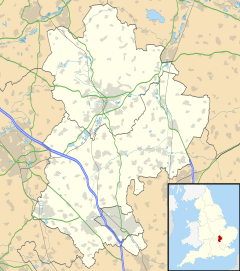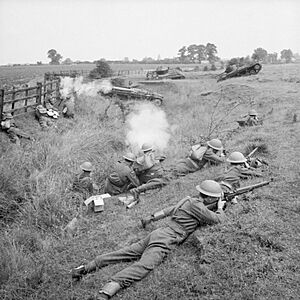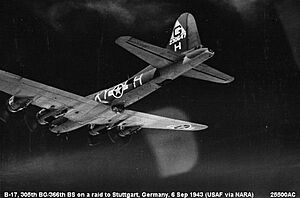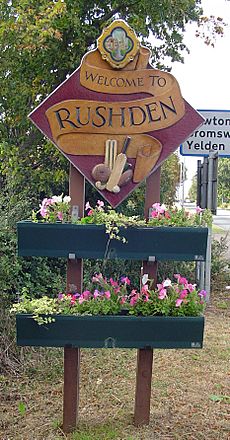Yelden facts for kids
Quick facts for kids Yelden |
|
|---|---|
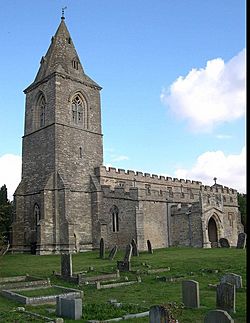 Yelden Church |
|
| OS grid reference | TL011746 |
| Civil parish |
|
| Unitary authority | |
| Ceremonial county | |
| Region | |
| Country | England |
| Sovereign state | United Kingdom |
| Post town | BEDFORD |
| Postcode district | MK44 |
| Dialling code | 01933 |
| Police | Bedfordshire |
| Fire | Bedfordshire and Luton |
| Ambulance | East of England |
| EU Parliament | East of England |
| UK Parliament |
|
Yelden or Yielden is a small village in Bedfordshire, England. It's located near the borders of Northamptonshire and Cambridgeshire. The village sits by the River Til, which flows into the Great Ouse valley. It's about 70 meters (230 feet) above sea level.
Yelden is about 14 miles (22.5 km) north of Bedford. The land around the village is mostly open and used for farming. It rises to about 90 meters (295 feet) above sea level.
A main feature of the village is the Yielden Castle site. This is where a Norman castle once stood. Today, you can see grassy mounds and earthworks from the old castle.
Other important places in Yelden include the Church of St Mary. There was also a Wesleyan Chapel built in 1884. The Chequers Public House used to be a popular spot but closed in 2016. The Yelden Village Hall is still a community hub.
Today, about 150 to 200 adults live in Yelden. There are also between 50 and 100 children. They live in around 90 homes.
Neighbouring villages include Melchbourne, Newton Bromswold, Upper Dean, and Shelton.
Contents
Village History
Archaeologists have found signs that people have lived in Yelden for a very long time. This goes back to the late Stone Age and early Bronze Age. That's around 2000 to 800 BC!
The village was mentioned in the Domesday Book of 1086. This was a big survey of England ordered by William the Conqueror. In 1931, Yelden had 150 people. In 1934, Yelden joined with Melchbourne. They formed a new parish called "Melchbourne and Yelden."
Yelden Castle: A Norman Stronghold
Yielden Castle is a very important historical site. It's one of the most interesting castles of its kind in the area. This was once a Norman motte-and-bailey castle. A motte-and-bailey castle has a large mound (the motte) with a tower on top. It also has a walled courtyard (the bailey) below.
From the Domesday Book until the 1200s, this castle belonged to the Trailly family. The central mound rises about 40 feet (12 meters) above the moat. The castle has two levels and two large courtyards.
Some people think an ancient British tribe called the Iceni lived here before the Normans. They might have even fought the Romans at this spot. However, historians have different ideas about this. By 1360, the castle was no longer used and had become a ruin.
Church of St Mary
The Church of St Mary is a beautiful village church. It was mostly built in a style called "Decorated." The Trailly family received the church from monks in the early 1100s. This was confirmed by a special document from Pope Alexander III in 1162.
Even though it has Norman roots, the church doesn't look Norman today. It has a main area (the Nave) and a special part near the altar (the Chancel). These parts date back to the early 1200s. The church has been changed a lot over the years. Its most striking features are the tower and its pointed spire.
Yelden During World War II (1939-1945)
World War II was a big time for Yelden. This was because of its closeness to Chelveston Aerodrome. This airfield was built with three runways in 1941.
In 1942, a special group started flying Horsa gliders from the airfield. These gliders were pulled by large Short Stirling aircraft. Later that year, the United States joined the war. The airfield became home to the United States Army Air Forces 305th Bombardment Group. This group flew Boeing B-17 Flying Fortress planes. They were pioneers in flying and bombing during the day.
Almost 2,000 people worked at the airfield. They flew 337 missions between 1942 and 1945. They dropped over 22,000 tons of bombs on enemy targets. They also shot down 332 enemy planes. Sadly, 154 Allied planes were lost, and 810 airmen died.
Buildings and a Tragic Crash
During the airfield's building, new homes were put up in the village. These were meant for the Women's Auxiliary Air Force (WAAF). But instead, they became a place for American sergeants to live. These buildings were known as "the camps." Over time, they fell apart and were torn down. New houses now stand on these sites. These new areas are called Philips Medows, Stanbrook Way, and Forge Gardens.
On March 24, 1944, a Boeing B-17 Flying Fortress bomber crashed. It belonged to the US Army Air Force. The plane crashed during takeoff from RAF Chelveston. All 10 crew members died. Tragically, 11 people on the ground also lost their lives. Today, Forge Gardens is built on the crash site.
In May 2009, a special service was held at the village church. A plaque was placed to remember those who died in the crash. Two children, Keith (14) and Monica (4), were killed. The plane hit the house where they were sleeping. Other people who died were servicemen in a barracks building that the plane hit. Some people say that you can still hear the distant sound of a B-17 plane early in the morning. There are also stories of ghostly airmen seen near the churchyard and crash site.
Notable People from Yelden
Dick Rodgers: A Wartime Hero
In June 1943, an American pilot named Dick Rodgers helped Yelden. The village had fewer people because of the war. Rodgers helped organize the famous Strawberry Fayre. He became very popular in the community. He encouraged other American pilots to help raise money for the local church.
Dick Rodgers died while on a supply mission during the Battle of the Bulge. His body was never found. But there is a special plaque on a bench outside the church. It remembers his bravery.
Joe Ekins: Tank Gunner
Joe Ekins (1923 – 2012) was born in Yelden. He was a tank gunner. Some people believe he was the one who defeated the famous German tank commander Michael Wittmann.
How Yelden Got Its Name
Like many old places, Yelden's name has changed over time. The first recorded name was 'Giveldene' in 1086. Since then, it has changed more than 20 times! For a while, around 1390, it was called 'Yelden'. Then it became 'Yeveldene' in 1461. Other names included Chivelden, Gyueldene, and Yielding.
Finally, it was recorded as 'Yelden' again in 1830. The name 'Yielden' has become common more recently.
If you visit Yelden, you might see different spellings on road signs:
- Yelden
- Yielden
- Yeldon
There has been a lot of discussion about the correct spelling. It can still be confusing for visitors. In 1998, villagers were asked which spelling they preferred. 44 people thought it was 'Yelden', and 30 thought it was 'Yielden'.
Different groups use different spellings. The Royal Mail uses "Yielden" for addresses. But the local council calls itself "Melchbourne and Yelden" parish council. The government's Office for National Statistics uses "Melchbourne and Yielden." The Ordnance Survey maps show the village as "Yelden" but the parish as "Melchbourne and Yielden."
Yelden Today
Strawberry Fayre: A Village Tradition
Yelden is well-known for its Strawberry Fayre. This fun event happens every year on the last Sunday in June. Thousands of visitors come to the village for it. They enjoy things like strawberry teas, live jazz music, and classic cars. There are also traditional summer fair activities. All the money raised helps the Church.
The Chequers Inn
The Chequers Inn was the village pub. It closed its doors in 2016. There have been ideas to reopen it, perhaps with new homes built nearby. But as of June 2021, the pub remains closed.


